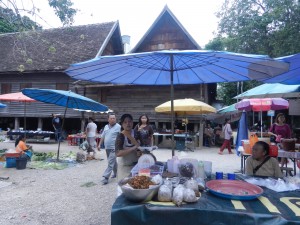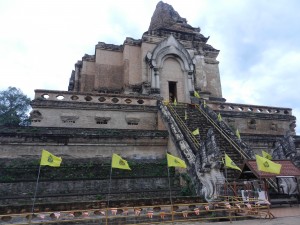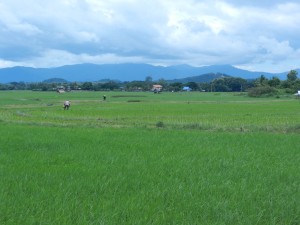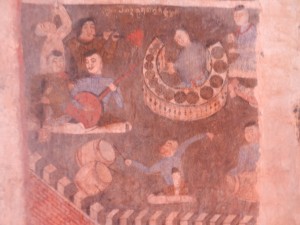Chiang Mai was the capital of the Lan Na Kingdom before Siam incorporated it at the end of the 19th century. Lan Na created one of Southeast Asia’s greatest artistic heritages after Chiang Mai’s founding in 1296. More than 100 chronicles of Lan Na’s political history were written and stored in monasteries–this culture valued literature.
Most cultures’ political chronicles are usually serious because they’re supposed to legitimize the current dynasty, but Chiang Mai chronicles have Thai traits that make this part of the world very appealing.
The Chiang Mai chronicles begin seriously enough.
They start with a history of a line of hundreds of thousands of kings that were connected with the Buddha. For example, there were 276,275 rulers from Mahasamantaraja to Vesantara–the latter was the last of the Buddha’s incarnations before his historical existence as Gotama. So the Chiang Mai chronicles ground their royal line in the Buddha’s merit, and in the grandeur of India’s vast ideas of time and cosmology. Great for ensuring that royalty is respected.
Wat Chedi Luang (in the above photo) is the one building in Chiang Mai that reflects this larger-than-life view of reality. But all its other wats are human-scale, and the Chiang Mai chronicles also quickly take a Thai turn.
Its perspective shifts from the enormous Indian landscapes to Lan Na’s own kings, and it begins to devote more space to them when Chiang Mai’s founder, Mangrai, is on the throne. The chronicles reflect Lan Na’s landscape of small valleys and rivers fingering between mountains under 10,000 feet. But they take yet another Thai turn.
In the fourteenth century, an ugly merchant named Ngua Hong lived in an important town on the Mekong called Chiang Saen–the above picture is from Chiang Saen’s banks. He and King Kham Fu were close friends, and Ngua Hong stayed in the royal palace whenever he visited the capital, and he got full hospitality–a beautiful noble woman or a wife of the king bathed his feet, even though they didn’t find him attractive. But one day the king decided to play a trick on his friend.
Kham Fu took a shaved monkey, painted skin on him with gum from trees, and stuck white cotton in it to look like body hair. He sealed him in a box and had two court comedians carry it to Ngua Hong with a message that that the king is sending him this handsome servant.
Ngua Hong was furious! Beauty meant a lot in Lan Na, as the figures on Chiang Mai’s Wat Phra Singh’s library (above) attest. He chased the two jokers, but they were able to get away. Kham Fu knew that his friend was in a huff, so he traveled to Chiang Saen to calm him. When he arrived at his home, one of Ngua Hong’s wives greeted him and bathed his feet. She was beautiful, and she and the king were both aroused. He signaled his desire to her with his hands, and both bedded together for the whole night.
Ngua Hong never found this out, but a week later, the king went to a river that flows into the Mekong to wash his hair. A water ogress rose up and pulled him down into her lair. His body surfaced seven days later.
This sounds like a folk tale, which Lan Na’s court and monks probably incorporated to illustrate Buddhist ethics–Control your passions or else. But like Lan Na sculptures and paintings, the story is told with a sense of fun and love of beauty that can make you more attached to the world which Buddhism is supposed to liberate you from. Sure I want to reach nirvana, but can we wait a while so I can keep enjoying life?
It’s hard not to think like this in northern Thailand’s beautiful natural landscape, with its fun-loving people and arts that are both elegant and folksy. It brings India’s view of the vast universe down to earth, and encourages you to enjoy its delights. Count me among the faithful!







Comments on this entry are closed.